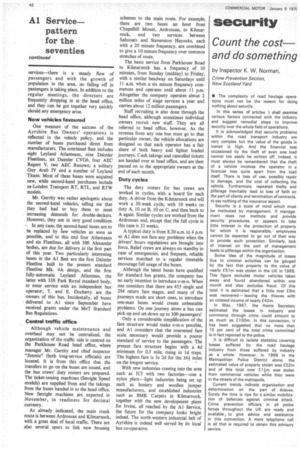Al Service— pattern for the seventies
Page 48

If you've noticed an error in this article please click here to report it so we can fix it.
continued
services—there is a steady flow of passengers and with the growth of population in the area, no falling off in passengers is taking place. In addition to the regular meetings, the directors are frequently dropping in at the head office, and they can be got together very quickly should any emergency arise.
New vehicles favoured
One measure of the success of the Ayrshire Bus Owners' operations is reflected in the vehicle policy, and the number of buses purchased direct from manufacturers. The combined fleet includes eight Leyland Atlanteans. nine Daimler Fleetlines, six Daintier CVG6, four AEC Regent V. two AEC Renown, a solitary Guy Arab IV and a number of Leyland Titans. Most of these buses were acquired new, while second-hand purchases include ex-London Transport RT, RTL, and RTW models.
Mr. Garrity was rather apologetic about the second-hand vehicles, telling me that they had had to buy them to meet increasing demands for double-deckers. However, they are in very good condition.
In any case, the second-hand buses are to be replaced by new vehicles as soon as possible, and to this end four Atlanteans and six Fleetlines, all with 30ft Alexander bodies, are due for delivery in the first part of this year. Two particularly interesting buses in the Al fleet are the first Daimler Fleetline built to the present standard Fleetline Mk. 4A design, and the first fully-automatic Leyland Atlantean, the latter with 33ft Park Royal standard body, to enter service with an independent bus operator; T. and E. Docherty are the owners of this bus. Incidentally, all buses delivered to Al since September have received grants under the MoT Standard Bus Regulations.
Central traffic office
Although vehicle maintenance and overhaul may not be centralized, the organization of the traffic side is centred on the Parkhouse Road head office, where manager Mr. Garrity and chief inspector "Jimmie" (both long-service officials) are located. It is from this office that the transfers to go on the buses are issued, and the bus crews' duty rosters are prepared. The ticket-issuing machines (Setright Speed models) are supplied from and the takings from the buses handed in to the head office. New Setright machines are expected in November, in readiness for decimal currency.
As already indicated, the main trunk route is between Ardrossan and Kilmarnock, with a great deal of local traffic. There are also several spurs to link new housing schemes to the main route. For example, there are two buses an hour from Chapelhill Mount, Ardrossan, to Kilmarnock, and two services between Saltcoats and Stevenston Hayocks, each with a 20 minute frequency, are combined to give a 10 minute frequency over common stretches of route.
The basic service from Parkhouse Road to Kilmarnock has a frequency of 10 minutes, from Sunday (midday) to Friday, with a similar headway on Saturdays until 11 a.m. when a six minute frequency commences and operates until about 11 p.m. Altogether the company operates about 2 million miles of stage services a year and carries about 12 million passengers.
Staff recruiting is also done through the head office, although sometimes individual owners recruit new staff. They are all referred to head office, however. As the revenue from any one bus must go to that particular owner, the vehicle allocations are designed so that each operator has a fair share of both heavy and lighter loaded journeys. Cash takings and cancelled tickets are handed over at head office, and are then passed on to the appropriate owners at the end of each month.
Duty cycles The duty rosters for bus crews are worked in cycles, with a board for each duty. A driver from the Kilmarnock end will work a 30-week cycle, with 10 weeks on duty A, 10 on B, 10 on C, and then back to A again. Similar cycles are worked from the Ardrossan end, except that the full cycle in this case is 33 weeks.
A typical duty is from 8.20 a.m. to 4 p.m. so Al does not face any problems when the drivers' hours regulations are brought into force. Relief crews are always on standby in case of emergencies, and frequent, reliable services matched to a regular timetable encourage full usage of the buses.
Although the latest buses have qualified for standard bus grants, the company has no early intention to introduce o-m-o. When one considers that there are 455 single and 294 return fare stages. and many of the journeys made are short ones, to introduce one-man buses would create unbeatable problems. On one journey alone a bus can pick-up and set-down up to 300 passengers!
Only a considerable simplification of the fare structure would make o-m-o possible, and Al considers that the coarsened fare scale necessary would provide a poorer standard of service to the passengers. The present fare structure begins with a 4d minimum for 0.5 mile, rising in Id steps. The highest fare is 3s 2d for the 16; miles on the longest service.
With new industries coming into the area such as ICI with two factories—one a nylon plant—light industries being set up such as hosiery and woollen jumper manufacturers, and established industries such as BMK Carpets in Kilmarnock, together with the new development plans for Irvine, all reached by the Al Service, the future for the company looks bright indeed. The north-western industrial belt of Ayrshire is indeed well served by its local bus co-operative.








































































































